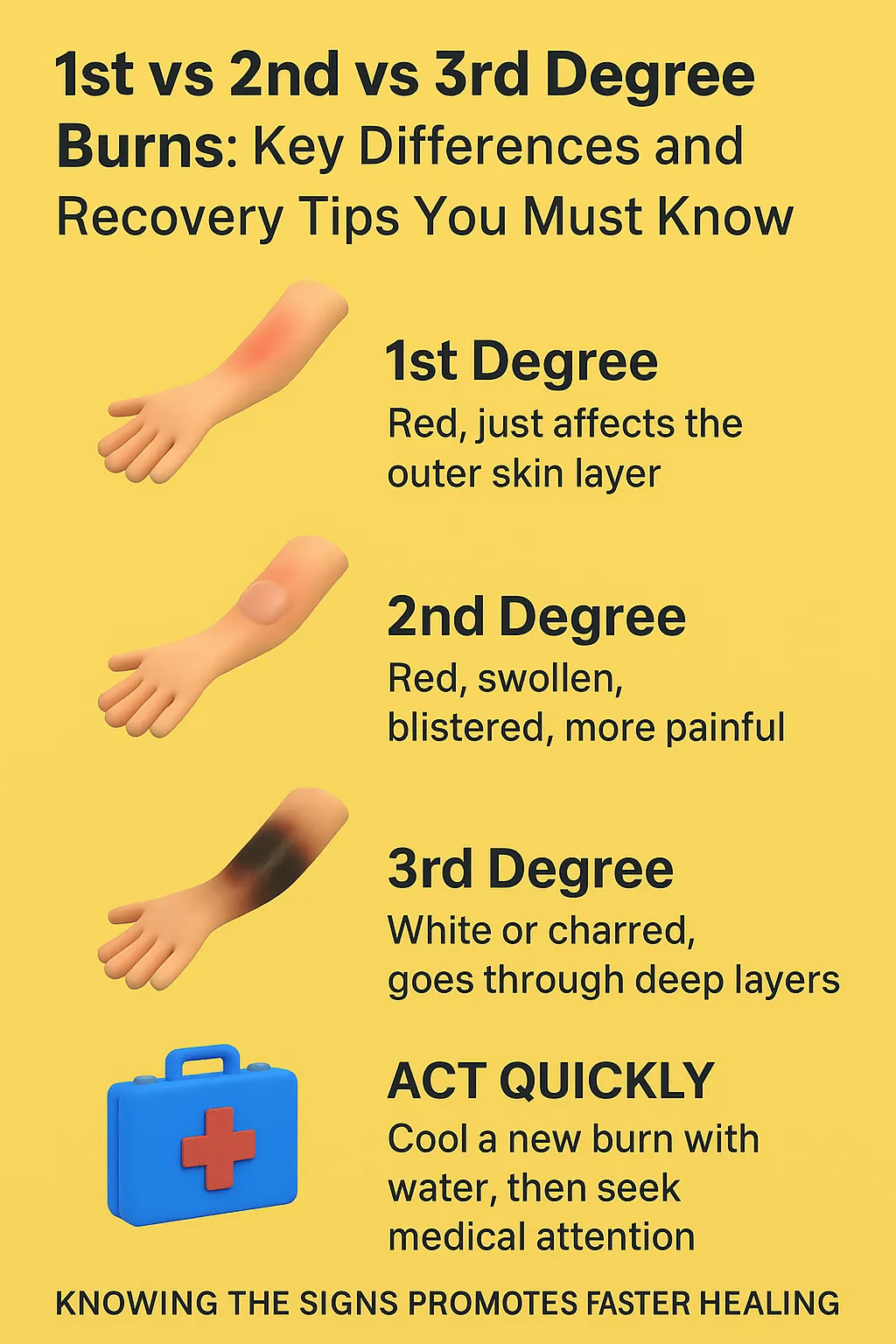The moment a burn happens, the first question is always the same: Is this something I can handle at home, or does it require emergency care? Too often, people underestimate the severity of burns—treating a serious injury like a simple sunburn—and end up facing infections or long-term scarring. That’s why knowing the difference between first, second, and third-degree burns is not just helpful, but essential for safe healing.
Drawing on medical guidance and real-life examples, this guide explains what each burn looks like, how the body responds, and the steps you should take right away. Recognizing these signs early helps you decide when home care is enough and when it’s critical to seek professional treatment, especially when understanding the differences between 1st vs 2nd vs 3rd degree burns becomes the key to making safe, timely decisions.
Quick Takeaways
- Early action: Prevents infection, scarring, and serious complications
- First aid: Cool water, clean covering, avoid oils and home remedies
- Get medical help: Large, deep, blistering burns or those on face/hands/groin
- Prevention: Adjust water heater settings, supervise children, use protective gear
How to Recognize and Treat Different Burn Degrees
First-Degree Burns
The mildest form, affecting only the top layer of skin. They appear red, feel sore, and resemble a sunburn. Most heal within a week with cool compresses, aloe vera, and over-the-counter pain relief.
Second-Degree Burns
These go deeper into the skin, often causing painful blisters, swelling, and wet or shiny skin. Small ones can usually heal with home care, but larger or widespread burns should be seen by a doctor to prevent infection.
Third-Degree Burns
The most severe, destroying all layers of skin and sometimes damaging tissue beneath. The skin may appear white, leathery, brown, or charred. Surprisingly, they may not hurt due to nerve damage. This type requires immediate emergency treatment.

When to Seek Help
Seek medical attention if a burn:
- Is larger than the palm of your hand
- Involves sensitive areas like the face, hands, or genitals
- Appears deep or has significant blistering
- Shows signs of infection such as spreading redness, pus, or fever
Real-Life Scenarios
Kitchen Accident
Hot water splashes on the arm. At first, the skin looks red, but within hours painful blisters form. This is a second-degree burn that needs medical care to prevent scarring.
Workplace Burn
A worker touches overheated machinery. The skin turns pale and leathery, but there’s little pain. Diagnosis: third-degree burn with nerve damage—emergency care is essential.
Everyday Sunburn
After a day in the sun, redness develops, followed by peeling. This is a first-degree burn. It usually heals well, but frequent burns increase the risk of skin cancer.
Why Early Recognition Matters
- Scalds cause about 35% of burn injuries, and most involve children under 5 (American Burn Association – Scald Prevention)
- Setting water heaters to 120°F can prevent many home-related burns (Consumer Product Safety Commission)
Around 80,000 children are treated annually in ERs for burns, with about 300 deaths each year (CDC – Burn Prevention)
- Third-degree burns may not hurt, but they’re life-threatening and often require skin grafts (MedlinePlus – Burns)
Takeaway: Burns often look less severe than they are. Recognizing their true depth can prevent lasting harm.
Final Thoughts
Burns are one of the most underestimated injuries. From toddlers scalded by bathwater to workers with “painless” burns, I’ve seen how quickly things escalate. Early recognition and fast action often make the difference between a smooth recovery and lifelong damage.
Remember:
- Know the signs of each burn degree
- Take prevention seriously—protective gear, safe water temperatures, and child supervision
- If in doubt, seek medical care immediately
Next Steps After a Burn
- Assess: Identify whether it’s 1st, 2nd, or 3rd degree. If unsure, assume it’s serious
- Give First Aid: Cool with running water, cover with a sterile bandage, avoid home remedies like butter or oil
- Seek Medical Help: Call 911 for major burns. See a doctor for blistering or burns in sensitive areas
- Prevent Infection: Keep the wound clean, change dressings, and monitor for signs of infection
Prevent Future Burns: Adjust water heaters, supervise children, and use protective gear at work
FAQ: 1st vs 2nd vs 3rd Degree Burns – Key Differences and Recovery Tips
How can I tell the difference between burn degrees?
- 1st-degree: Red, mild pain, like a sunburn.
- 2nd-degree: Blisters, swelling, strong pain.
- 3rd-degree: White, leathery, or charred skin, may feel numb.
How long does healing take?
- 1st-degree: A few days to a week.
- 2nd-degree: Two to three weeks.
- 3rd-degree: Months, often needs medical treatment or surgery.
What should I do right after a burn?
Cool with running water, cover with a clean bandage, and take pain medicine if needed. Don’t use butter, oil, ice, or toothpaste.
When should I see a doctor?
If the burn is large, deep, on the face, hands, feet, or genitals, or if there are signs of infection like pus or fever.
How can I help a burn heal?
Keep it clean and covered, change bandages regularly, drink plenty of water, eat healthy foods, and protect skin from the sun.
When learning about 1st vs 2nd vs 3rd Degree Burns: Key Differences and Recovery Tips You Must Know, it’s helpful to recognize how overall health and environment play a role in recovery. Just as maintaining clean indoor air supports healing, tools like the 15x15x2 Air Filters and 20x20x1 Pleated Furnace Platinum ensure breathable air that benefits skin repair. Likewise, services such as HVAC Replacement Miami Beach FL highlight the importance of reliable systems for comfort and safety during recovery. Accessible solutions, including the 10x30x1 MERV 8 Pleated HVAC AC Furnace Air Filters 5-Pack, further connect to healthier spaces, while platforms like discount furnace filters online offer affordable options for those seeking practical home support. Together, these resources align with the article’s focus on understanding burn stages while also ensuring a recovery environment that fosters healing.










